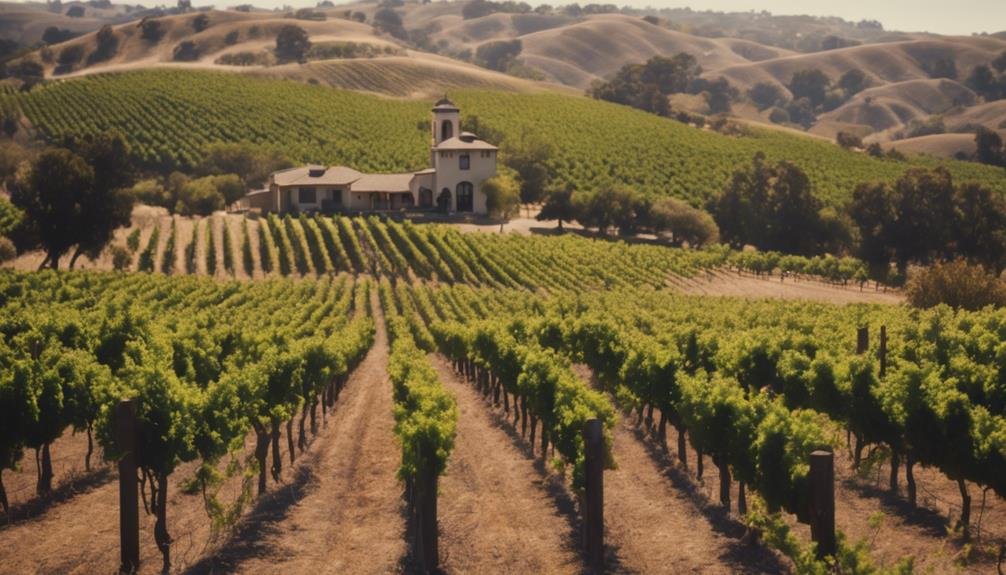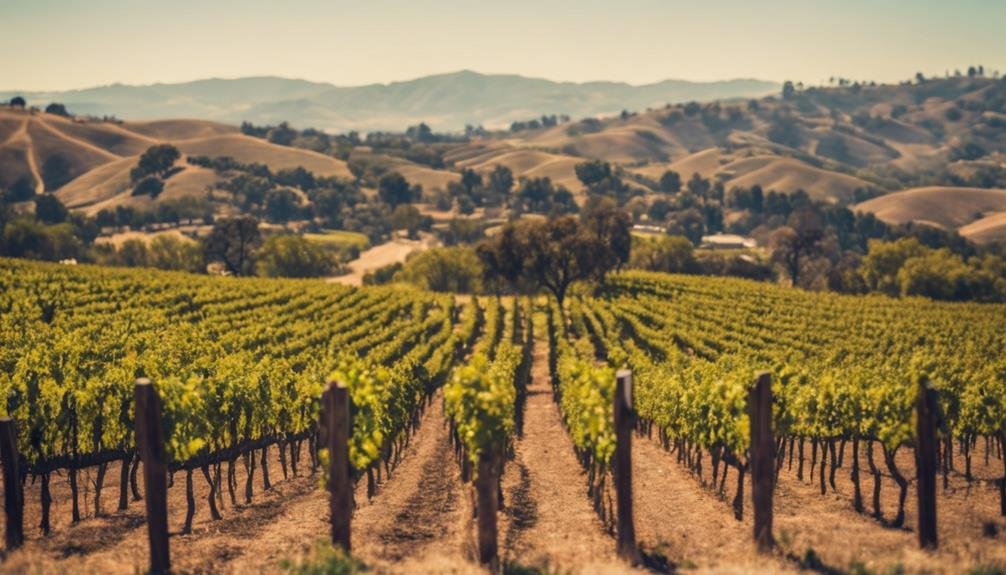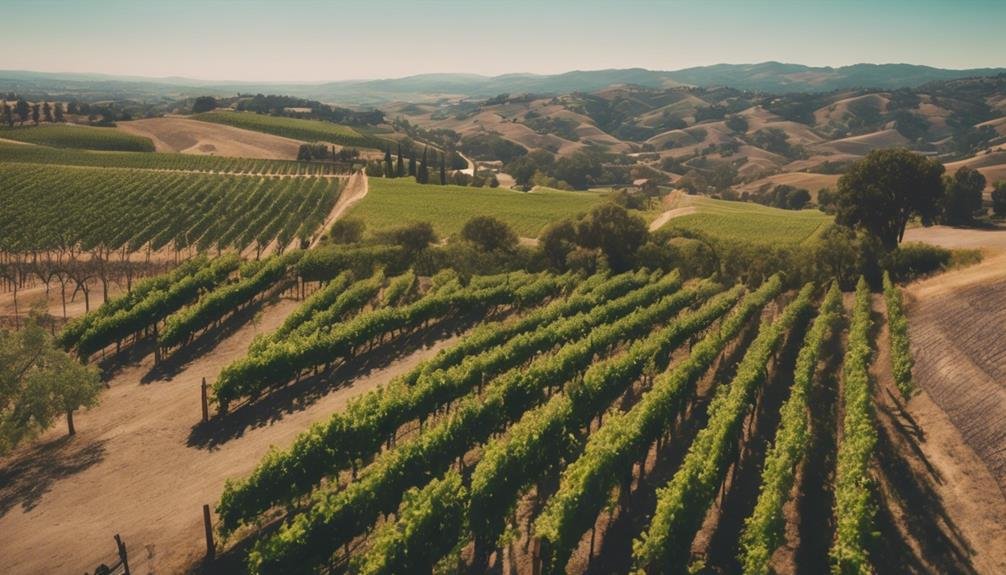The Paso Robles wine scene highlights opulent red wines with firm acidity, crafted through techniques like extended maceration and oak aging. Diverse terroirs, including calcareous soils and temperature shifts, lend complexity to these sought-after wines. Adelaida, Willow Creek, and El Pomar are renowned districts within Paso Robles, each offering unique varietals. Tasting tips include using a spittoon, starting light, and note-taking for an enriching experience. With over 200 wineries emphasizing sustainability, Paso Robles' global appeal lies in its commitment to quality and diversity. Explore your palate to discover more about the vibrant Paso Robles wine scene.
Key Styles of Paso Robles Wines
Recognized for a diverse range of key styles, Paso Robles wines showcase a distinct profile characterized by opulent, sweet-fruited red wines with plush mid-palates and high alcohol levels alongside firm acidity.
These wines pair excellently with a variety of foods, from rich meats like grilled lamb and ribeye steaks to savory dishes like mushroom risotto and aged cheeses.
Winemaking techniques in Paso Robles often involve extended maceration periods to enhance color and flavor extraction, followed by aging in a combination of new and neutral oak barrels to add complexity and structure.
The use of modern winemaking equipment and practices, such as temperature-controlled fermentation tanks and gentle grape pressing methods, helps to preserve the fruit-forward characteristics and bold flavors that define Paso Robles wines.
Paso Robles Terroir Insights
Paso Robles' terroir is characterized by its diverse soil series within the largest AVA in California, featuring calcareous soils that enhance flavor concentration in the region's wines. The soil composition in Paso Robles varies, with different areas having clay loam, sand, or limestone soils, contributing to the unique characteristics of the wines produced.
Temperature fluctuations play an important role in shaping the grapes grown in Paso Robles, with average growing season temperatures reaching as high as 105°F. These extreme temperatures, combined with significant diurnal shifts, help maintain acidity in the grapes, leading to the production of powerful wines with a distinct flavor profile.
Understanding the terroir of Paso Robles is essential for appreciating the quality and diversity of wines that this region has to offer.
Paso Robles Wine Regions Overview

The discovery of Paso Robles' wine regions reveals distinct characteristics that contribute to the diverse and vibrant viticultural landscape of this renowned wine-producing area.
- Adelaida District: Known for its high elevation vineyards, ideal for producing bold reds and aromatic whites.
- Willow Creek District: Emphasizes Rhône varietals with a focus on Syrah and Grenache.
- Templeton Gap District: Recognized for its cooling marine influence, resulting in balanced wines, especially Cabernet Sauvignon.
- El Pomar District: Noted for its diverse soil types, producing a wide range of wine varietals.
- Creston District: Known for its warmer climate, ideal for growing rich and full-bodied wine varietals.
Paso Robles Wine Tasting Tips
When beginning a wine tasting experience in Paso Robles, it is recommended to use a spittoon as a tool for ideal tasting etiquette and enjoyment. Spit bucket etiquette is important in tasting rooms to discreetly dispose of wine during a tasting without offending others or affecting your judgment.
Starting with lighter wines and avoiding strong scents before the tasting can help preserve your palate's sensitivity. It's vital to stay hydrated throughout the tasting to cleanse your palate between wines.
Taking notes during tastings can aid in remembering your favorites and reflecting on the tasting experience later. Following these tasting room etiquettes can enhance your Paso Robles wine tasting experience and ensure a more enjoyable and informative exploration of the diverse wines in the region.
General Information About Paso Robles

After exploring proper wine tasting etiquette in Paso Robles, it is important to understand the general information about this renowned wine region in California.
- Located in California
- Known for Zinfandel and Rhône varietals
- Diverse microclimates
- Over 200 wineries
- Emphasis on sustainable wine practices
Paso Robles attracts wine enthusiasts from around the world due to its diverse microclimates and unique varietals. With over 200 wineries, the region offers a rich tapestry of flavors to explore. Visitors can enjoy wine tourism experiences while appreciating Paso Robles' commitment to sustainable practices, ensuring the longevity of its winemaking traditions.
Frequently Asked Questions
How Has the Recent Wildfires Impacted Paso Robles Wineries?
The recent wildfires in Paso Robles have had a significant impact on wineries, prompting emergency response efforts and rallying community support. The economic repercussions have been challenging, but recovery efforts are underway to restore the affected vineyards and businesses.
What Sustainable Practices Are Most Common Among Paso Robles Vineyards?
Sustainable practices in Paso Robles vineyards commonly include organic farming methods to reduce chemical usage and promote soil health. Water conservation techniques, such as drip irrigation and cover crops, are also prevalent to guarantee efficient water usage.
Are There Any Famous Celebrity-Owned Wineries in Paso Robles?
Celebrity-owned wineries in Paso Robles add allure to the region, offering unique tasting experiences, collaborations, and vineyard tours. These partnerships bring star-studded tastings and VIP events, enhancing the wine scene with exclusive encounters.
How Are Paso Robles Winemakers Adapting to Climate Change Challenges?
Paso Robles winemakers are adapting to climate change challenges by implementing water conservation practices and utilizing innovative techniques. They are also selecting heat-resistant grape varieties to guarantee quality production and sustainability in the face of evolving environmental conditions.
What Unique Experimental Grape Varietals Are Being Grown in Paso Robles?
In Paso Robles, vintners cultivate climate-resistant grapes and craft artisanal blends, showcasing a commitment to experimentation and innovation. These unique varietals contribute to the region's dynamic wine landscape, embracing diversity and resilience.
Conclusion
In the vibrant tapestry of Paso Robles wine culture, each bottle tells a story of the region's rich history, unique terroir, and innovative winemaking techniques.
From opulent Zinfandels to bold Bordeaux blends, every sip uncovers a new layer of complexity and depth.
With over 200 wineries to explore and a diverse array of styles to taste, Paso Robles invites wine enthusiasts on a journey of discovery and delight.
Cheers to the unrestrained spirit of Paso Robles wines!
